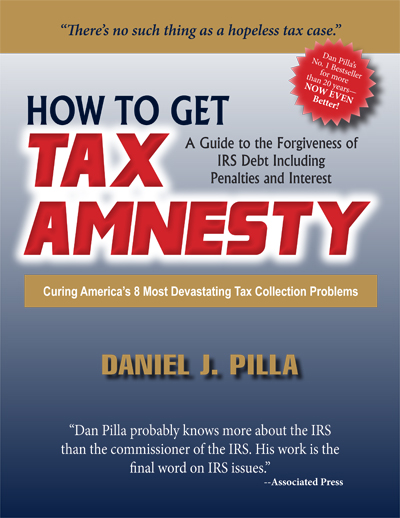Solving 29 of America’s Most Common IRS Problems
Part I – One Thing Every Citizen Must Know
Let us begin with what could be the single most important development in taxpayers rights in twenty years’ the Taxpayer Advocate (TA). The Taxpayer Advocate, formerly known as the Problems Resolution Officer, was created by the Taxpayers’ Bill of Rights Act of 1988. The purpose of the TA is to function as a liaison between the IRS and the citizen. The TA’s role is to step in where normal channels fail and help citizens resolve cases that otherwise might lead to hardship.
Each year, the TA helps thousands of people resolve disputes surrounding tax refunds, improper audits, installment agreement issues, penalty assessments and so on. However, precious few people realize the TA exists and consequently, few take advantage of this resource. With the passage of the 1998 IRS Restructuring and Reform Act, the power of the TA is expanded. Now more than ever, the TA is a tool that every citizen must be aware of and understand how to use.
Problem 1 Nobody in the IRS cares.
I need help–quick!! The IRS has or is about to levy a bank account or pay check. It refuses to issue a refund I am entitled to and need. It is taking some action that will cause hardship if allowed to proceed.
CONSEQUENCE: The agency continues to deprive you of rights or otherwise takes action which causes a hardship, such as enforced collection, failure to issue a refund, etc.
SOLUTION: Immediately contact the Taxpayer Advocate
Read more
The Taxpayer Advocate is charged with the affirmative duty to step in and set things right when the IRS otherwise fails to do its job. The TA operates to smooth out the rough spots in tax law enforcement. This office should be used anytime there is a failure on the part of the IRS to:
- take action it should, such as issue a refund, or
- refrain from taking action, such as carrying out a wage or bank levy.
Gain access to the TA in one of two ways:
- The first is to use Form 911, Application for Taxpayer Assistance Order. The Taxpayer Assistance Order (TAO) is an order commanding the IRS to either stop action or take action, as the case may be. The agency is required by law to follow a TAO.
- The second way to access the TA is to merely write a letter to the local TA in your district. Previously, the IRS refused to publish the addresses and phone numbers of the various TA offices. However now you can go to https://www.taxpayeradvocate.irs.gov to locate your local office.
There are several points to keep in mind about your communications with the TA.
First, give clear and succinct details about the facts of the case. Explain what has happened and when, and who is responsible for the actions at issue. Give names and dates and if possible, provide copies of past letters.
Second, be clear about the damage or hardship that you are or will suffer as a result of the actions. For example, if the IRS is threatening a wage levy and will not negotiate a reasonable installment payment (specific procedures for installment agreements are discussed in Part II of this 29 Common Problem Solutions), the damage is loss of wages and the resulting inability to pay monthly living expenses.
Third, be clear and succinct about the relief you are seeking. In the case of the installment payment, state that you want the TA to order the IRS to accept your installment payment of “X” dollars per month. Be sure to sign your letter and give a phone number where you can be reached. You must show a willingness to cooperate with the TA and meet all of IRS’ legal demands before you can expect the TA to respond favorably.
A word of caution about the Form 911.
When you submit Form 911, whether the TA grants the request or not, signing the form operates to toll the collection statute of limitations. The collection statute is the rule of law that limits the IRS’ right to collect taxes. Ordinarily, the agency has just ten years from the date of a tax assessment in which to collect. After that period, the IRS’ legal right to collect expires. However, by signing Form 911, you extend that ten-year period beginning with the date of submitting Form 911 and continuing to the date of its disposition by the TA. That is why I like to use the letter method of contacting the TA rather than Form 911. The letter does not stop the collection statute.
Chapter seven of my book, How to Get Tax Amnesty, provides more ideas on dealing with the TA, including specific examples of how the TA can help. Also, chapter ten of that book explains the collection statute of limitation, how to calculate the collection statute and what to do if you believe your collection statute has expired.
Solutions – Book Packages
Package 1
IRS Abuse Prevention Package $59
Helps solve problems #1, 2, 8, 12, 14, 15, 16, 17, 18, 19
Includes:
– Small Business Tax Guide
– How to Win Your Tax Audit
Package 2
Tax Problem Resolution Package $75
3 Best Sellers
Helps to solve problems listed in package 1, plus: #1, 5, 6-8, 10-17, 19, 22-26, 28
Includes:
– How to Get Tax Amnesty
– The IRS Problem Solver
– How to Win Your Tax Audit
IRS Defense Library $249
Helps to solve problems listed in package 2, plus: #9, 18, 21, 27, 29
Includes:
– All of Dan’s Current Books
– One year of Pilla Talks Taxes
Dan’s electronic newsletter
Back to 29 Problems Packages Back to Top
Packages qualify for one free 15 minute phone consult with Dan…$75 value



